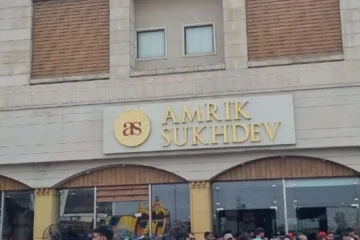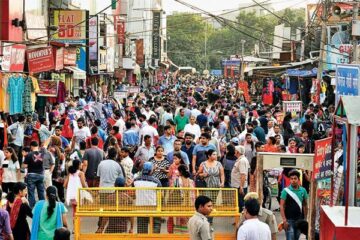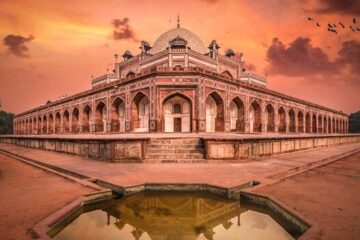Taj Mahal
Situated on the banks of River Yamuna, the Taj Mahal of Agra is a magnificent tribute to endless love. Mughal emperor Shah Jahan built the tomb of Mumtaz Mahal in the seventeenth century. The Taj, widely considered to be one of the most exquisite structures on earth, majestically symbolizes the pinnacle of Mughal design and grandeur. Due to its extraordinary beauty it is considered one of the seven wonders of the modern world. Do you still need an excuse to include it in your itinerary when you book your hotels in Agra? I do not think so!
Now that you know all you need to know about the Taj Mahal, let’s talk about its history, admission price, opening and closing times, architecture, surrounding attractions, and little-known facts.
Taj Mahal Information:
| Location | Agra, Uttar Pradesh |
| Timings | 30 minutes before sunrise to 30 minutes before sunset; closed on Fridays |
| Entry Fee | ₹ 50 for Indians; ₹ 1100 for foreigners; ₹ 540 for citizens of SAARC and BIMSTEC countries; free for children below 15 years of age |
| Main Mausoleum Entry Fee | ₹ 200 per head |
| Night Entry Timings | 8:30 pm to 12:30 am; close on Friday and during the month of RamzanNight viewing is allowed on five days every month – on the full moon night and two nights before and two after the full moon. |
| Night Entry Fee | ₹ 510 for Indians; ₹750 for foreigners; ₹500 for children between 3 to 15 years of age (Valid for 30 minutes)Tickets to be bought 24 hours in advance, between 10:00 am to 6:00 pm from the Archaeological Survey of India office on Mall Road |
| Still Camera | Free, but photography prohibited inside the main mausoleum |
| Years of Construction | 1632 to 1653 |
| Commissioned by | Shah Jahan |
| Type | Mausoleum |
| Status | UNESCO World Heritage Site, One of the Seven Wonders of the Modern World |
| Architectural Style | Mughal |
| Architect | Ustad Ahmad Lahauri |
| Material Used | A blend of Islamic, Persian, and Indian architectural styles |
| Cost of Construction | 32 million rupees |
| Area | 42 acres |
Taj Mahal: History
Mughal emperor Shah Jahan ordered the construction of the Taj Mahal, the largest monument ever built in the world, for his favorite wife, Mumtaz Mahal. Work on the tomb began on the banks of the Yamuna River in 1632, about a year after Mumtaz’s death. While the main mausoleum was built by 1643, the entire complex was not completed until 1653. Sadly, the emperor’s son, Aurangzeb, deposed him in 1658 and imprisoned him. During his dying days in captivity, Shah Jahan’s eyes fell upon his magnificent work from the nearby Agra Fort. When he died in 1666, he was buried next to his beloved wife in the Taj Mahal.
In the 18th century, the Jat kings of Bharatpur attacked Agra and looted the Taj Mahal. This monument was damaged by British soldiers and officers during the Revolution of 1857 when they took out precious stones from its walls.
In the early 20th century, Lord Curzon, the Viceroy of India at the time, supervised extensive restoration work on the Taj Mahal. After the independence of India, this monument came under the control of the Government of India.
Taj Mahal Architecture
The Taj Mahal is a famous masterpiece of art that blends Persian, Indian and Islamic architectural features. The fourth part of the monument is bordered by the Yamuna river, while the remaining 42 acres of land is covered with jagged walls. Rajasthani white Makrana marble was used in its construction. Additionally, thousands of semi-precious and priceless gems were used to enhance the grandeur of the monument.
With four minarets located at each of the four corners, the Taj Mahal rests on a raised square pedestal. The cellars are housed in a symmetrical building with a massive dome and an arch-shaped entrance beneath the finial. Mock coffins of Mumtaz Mahal and Shah Jahan are displayed in the main hall of the mausoleum. On the lower level, inside a closed chamber, are the actual tombs.
The interior of the monument is as stunning as its exterior, which is a testament to Mughal artistry. Within the inner chamber, which is structured like an octagon, there are elaborate decorative details such as vines, flowers and fruits, 28 different types of precious and semi-precious stones, as well as Quranic verses on the tombs. While the base and coffin are exquisitely decorated, the crypts containing the major bodies are quite basic, in keeping with Islamic customs.
The construction of the Taj Mahal required the work of approximately 22,000 expert artisans, labourers, painters and stonecutters, in addition to a substantial sum of Rs 32 million. Apart from the mausoleum, the Taj complex also includes a guest house, a museum, a mosque and ornamental gardens.
Taj Mahal Garden, Agra
The expansive 980-square-foot Charbagh, or Mughal garden, encircles the Taj Mahal. The garden is divided among sixteen deep flowerbeds by raised paths. The entire location is made more beautiful by the placement of an elevated marble water tank between the tomb and the entrance gate. Originally, the famous Persian gardens served as the model for the Taj Gardens. But after assuming control of the Taj, the colonial rulers altered the garden’s topography to resemble London’s lawns.
Taj Mahal Museum
The modest but important Taj Museum is located inside the Taj Mahal complex and is home to many unique Mughal miniature paintings. Two ivory portraits of Shah Jahan and his wife from the 17th century are among the main attractions of the museum. Additionally, the museum has several caledon plates that disintegrate or change color when contaminated food is placed on them.
Museum Timings: 10:00 AM to 5:00 PM
Free admission to the museum
Taj Mahal: Today
The Taj Mahal is now considered a must-see attraction on every holiday in Agra. About 7 to 8 million people visit the monument every year, attracted by its remarkable beauty and amazing pieces of art. UNESCO designated it as a World Heritage Site in 1983. The monument was one of the winners of the New Seven Wonders of the World Initiative (2000–2007).
Things to See in the Taj Mahal Complex
The Taj Mahal complex is home to a number of exquisite buildings and sites, such as:
To the west of the mausoleum is a red sandstone mosque; The Mehman Khana, or assembly hall, is to the east of the mausoleum and is similar to a mosque; Jilaukhana, or courtyard area; And the market streets, or two streets, which are similar and start from the east and west gates and go to Jiloukhana.
the Eastern Gate (Fatehabadi Darwaza), the Western Gate (Fatehpuri Darwaza), the Southern Gate (Sidhi Darwaza), and the Great Gate, also known as the Tomb Gate or Darwaza-e-Rauza.
Taj Mahal Museum
Lesser-known facts about Taj Mahal, Agra
- Taj Mahal translates to “the Crown of Palaces” in Persian.
The Taj Mahal’s interiors have a 28-second reverberation time. This means that everything you say within this space will reverberate for a full 28 seconds.
In order to reduce the possibility of Japanese air strikes in 1942, the Taj Mahal was covered in scaffoldings. During the 1965 and 1971 India-Pakistan conflicts, a similar strategy was used.
In the event of a natural disaster, such as an earthquake, the Taj Mahal’s minarets are designed to tilt outward. - Qutub Minar is about five feet shorter than the Taj Mahal.
- On November 8, 2000, the monument disappeared from view of the audience thanks to an optical trick performed by the famous Indian magician PC Sorkar Jr.
- One of the first people to take a selfie at the Taj was George Harrison, lead guitarist of the famous Beatles band. For this reason, he used a fish-eye lens.
- The Taj glows milky white in the twilight, red in the morning and golden in moonlight.
- There are 99 calligraphic names of Allah written on the tombs.
- The original site of the Taj Mahal was supposed to be Burhanpur, in Madhya Pradesh, where Mumtaz Mahal died. But due to a lack of white marbles in that area, Agra was chosen as the final spot for the memorial.
Attractions near Taj Mahal
- Agra Fort (3.1 km)
- Jehangir’s Palace (3.1 km)
- Jama Masjid (4.1 km)
- Mankameshwar Temple (4.5 km)
- Tomb of Itmad-Ud-Daulah (6.7 km)
- Chini-ka-Rauza (7.2 km)
- Mehtab Bagh (7.8 km)
A timeless love tale etched in marble is the Taj Mahal. Why not sign up for a 5-day Golden Triangle tour and visit the other neighbouring historical monuments while touring the Taj Mahal? You won’t regret the vacation; we’re positive.



0 Comments